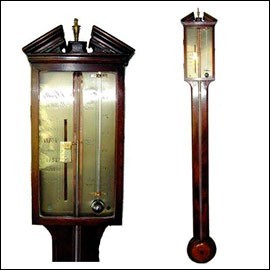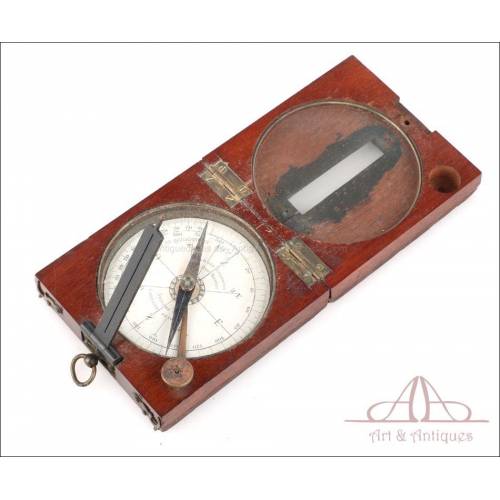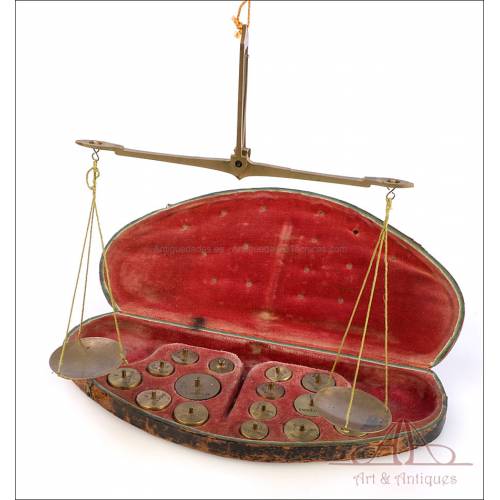Other Scientific Antiques
The scientific antiques hide within them all the passion for knowledge of the human being, as well as his incredible ingenuity when trying to cover it. Within this field we can find all kinds of pieces: from fascinating microscopes to laboratory equipment, as well as magnificent engineering instruments. But it is the most curious and special sci...
The scientific antiques hide within them all the passion for knowledge of the human being, as well as his incredible ingenuity when trying to cover it. Within this field we can find all kinds of pieces: from fascinating microscopes to laboratory equipment, as well as magnificent engineering instruments. But it is the most curious and special scientific antiques that often arouse greater admiration. Antique barometers, vintage thermographs, rare barographs, curious anemometers and nautical instruments with mysterious voyages behind them make up a very special universe, worthy of the best science and adventure novels.
Ancient barometers and antique barographs
The ingenuity of the inventors of the second half of the 19th century is displayed in the antique barometers and antique barographs present in our collections. The barometer is an element that measures atmospheric pressure; it is part of the mechanism of the barograph, an instrument that reflects such measurements on paper coils, from which data are obtained to make atmospheric predictions. Ancient barometers work according to the mechanism invented by Evangelista Torricelli in 1643, although the definitive name of these instruments was given to them by Edme Mariote twenty-three years later. As for the antique barographs, their mechanism is based on the system designed by Alexander Cumming around 1760. With this instrument, Cunning claimed to make the first record in history by using an aneroid cell.
Antique anemometers
Other scientific antiquesthat arouse our curiosity are antique anemometers. These fascinating instruments, fundamental in meteorology, are responsible for measuring wind speed. Apparently, the first anemometers were invented by the Mayan civilization (1200-1400 BC), where signs of the use of similar instruments have been found. But it was not until 1450 that the first anemometer as we know it was built. It was designed by Leon Battista Alberti, a humanist of reference and an essential figure of the Italian Renaissance. The antique anemometers that can be found today in the best collections are made according to their original design: a disk with a movable pendulum that oscillated driven by the wind, with a scale that marked its intensity. Today, it is possible to admire antique anemometers manufactured in the 19th century or early 20th century, with more complex mechanisms that combine a system of cups or blades with a dial or numbered dial.
Antique compasses
Antique compassesare highly sought after pieces by lovers of nautical antiques. The beauty of the polished brass, the magical precision of their mechanisms and their turn-of-the-century aesthetics transport us to times gone by, when ship voyages lasted months... The first compasses are believed to have been invented in China in the 9th century: their mechanism, a needle floating on a vessel filled with water, is similar to that of most antique compasses preserved today. However, there are voices suggesting that they could have been invented independently in Europe as well: interestingly, the needle of ancient Chinese compasses pointed south, while ancient European compasses always point north. The invention of the compass was an enormous advance, especially for maritime navigation, which until then was guided by the position of the celestial bodies.
Our collection of scientific antiquities is not only limited to these magnificent instruments. It is also possible to find antique thermographs, curious sundials more than a century old, collections of samples or specimens for microscopes that were part of period laboratories... All the knowledge of the scientists of past times, condensed in the most attractive and ingenious devices of antiquity.
Antique Ladois Wooden Military Compass. France, Circa 1875 Antique Ladois Wooden Military...
Fine-looking Ladois military compass in wooden box. Fine working order. Original from the 19th century. Fine-looking Ladois military compass...
SoldAntique Gold-Coin Scales. France, Circa 1800 Antique Gold-Coin Scales....
Wonderful antique scales for weighing gold coins. With complete weigh set and storing case. Entirely original. Wonderful antique scales for weighing...
290,00 € 370,00 €
New products
-

Antique ivory and silver plated stethoscope, late 19th century
Antique stethoscope from the late 19th century in silver-plated metal...
-

Vintage pendant with shell cameo of Jesús del Gran Poder, carved c. 1970
Vintage pendant with a shell-carved cameo of Jesus del Gran Poder, circa...
-

Antique Roman Style Gilded Silver Chalice with Paten. France, 1932
Antique Roman-style chalice in gilded silver with paten. France, 1932....
-

Beautiful Antique 18 K Gold Ring with 7 Natural Diamonds
Antique 18K gold ring with 7 natural diamonds. Delicate openwork design,...
-

Antique Silver Reliquary. José Vilaplana. Valencia, Spain. Circa 1920
Impressive repoussé silver reliquary by José Vilaplana, Valencia, c....
-

Vintage 18K Gold Ring with 7 Natural Diamonds
Vintage 18K gold ring with seven natural diamonds in floral setting....
-

Antique Silver Chalice. Enameled Crosses. Valencia, Spain, 1942
Spanish chalice from 1942 in solid silver, gifted by the Church of...
-

Antique Silver Chalice and Paten. Granada Spain, circa 1900
Spanish chalice in white silver with matching paten, handcrafted....
Specials
-

Antique Silver Chalice with Gilded Interior, Córdoba, 1889
Antique 1889 Spanish silver chalice...





